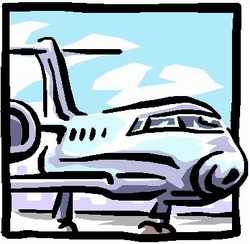So Don't Get Peeved With Auto Execs' Jets, Guys...
 In light of recent
publicity surrounding Congressional hearings about certain
companies' use of business aviation (read, the furor over the
CEOs of the Big Three US automakers flying to Washington, DC from
the same Detroit airport, each on their own bizjets, to beg
lawmakers for a $25 billion bailout -- Ed.)
the National Business Aviation Association says it has fielded
inquiries from representatives with news organizations and other
individuals about what business aviation is and how it is used in
the US.
In light of recent
publicity surrounding Congressional hearings about certain
companies' use of business aviation (read, the furor over the
CEOs of the Big Three US automakers flying to Washington, DC from
the same Detroit airport, each on their own bizjets, to beg
lawmakers for a $25 billion bailout -- Ed.)
the National Business Aviation Association says it has fielded
inquiries from representatives with news organizations and other
individuals about what business aviation is and how it is used in
the US.
To clear up a number of misperceptions, NBAA has provided the
following questions most often asked of the Association, with
responses that lay out the facts to explain how business aviation
helps companies of all sizes remain nimble, competitive and
successful... especially in a difficult economic climate. In the
interest of spreading the word as far as possible, ANN passes along
the list as well:
Q: Aren't business aircraft used mostly by major
corporations?
A: No, the vast majority of companies
using business aviation - 85% - are small and mid-size businesses
and other entities, including nonprofit organizations. For every
Fortune 500 company that relies on business aviation, there are
several small businesses that also need their airplane. Most
companies use just one business airplane, which typically seats six
passengers and flies relatively short stage lengths, mostly using
small community airports.
Q: Aren't the planes used just for CEO
transportation?
A: While each company has its own
policies for use of business aircraft, an NBAA survey revealed that
86% of passengers aboard business airplanes are mid-level people,
including salespeople, engineers, or other employees. Many
companies have a first-come-first-served policy for use of the
aircraft.
Q: Why would a company ever require an executive to fly
exclusively on a company airplane?
A: Some companies want their top
people to be in constant communication with the home office.
Security is also often a consideration, especially for companies
with a high public profile; business aircraft allow employees to
discuss proprietary information in a secure environment and without
fear of eavesdropping. And companies want to ensure that executives
are able to maintain flexible and nimble schedules, with reliable
transportation access to all the places they may need to reach on a
moment's notice.
 Q: Do companies just
use these planes to avoid the hassles of airline travel?
Q: Do companies just
use these planes to avoid the hassles of airline travel?
A: Companies that have their own
airplane often use the airlines. A survey conducted by NBAA several
years ago revealed that the Association's Member companies spend
$11 billion annually on travel with the airlines. NBAA makes
available software called "Travel$ense," which helps businesses
determine the best transportation option for a given mission.
Q: What are the kinds of trips where business aviation makes
more sense than a commercial flight?
A: Some examples might include trips
that involve destinations with little or no airline service;
missions that involve multiple stops in a single day; delivering
people or parts in real time (for example, flying emergency
equipment to a broken assembly line or providing a flight for
employees who need to discuss proprietary information).
Q: What should shareholders know about companies that have an
airplane?
A: Companies that have an airplane
return more to their shareholders than their competitors without
aircraft. Studies show business use of general aviation adds value
to a company's bottom line. Business people can make a trip
involving stops at several locations, then return to headquarters
the same day, saving time and travel expenses that would be needed
to make the same trip over several days via auto, train or airline
transport. Business aviation is a productivity tool - when
traveling aboard business aircraft, employees can meet, plan and
work with each other.
 ANN's Daily Aero-Linx (04.13.24)
ANN's Daily Aero-Linx (04.13.24) ANN's Daily Aero-Term (04.13.24): Beyond Visual Line Of Sight (BVLOS)
ANN's Daily Aero-Term (04.13.24): Beyond Visual Line Of Sight (BVLOS) Airborne 04.09.24: SnF24!, Piper-DeltaHawk!, Fisher Update, Junkers
Airborne 04.09.24: SnF24!, Piper-DeltaHawk!, Fisher Update, Junkers Aero-News: Quote of the Day (04.14.24)
Aero-News: Quote of the Day (04.14.24) ANN's Daily Aero-Term (04.14.24): Maximum Authorized Altitude
ANN's Daily Aero-Term (04.14.24): Maximum Authorized Altitude




